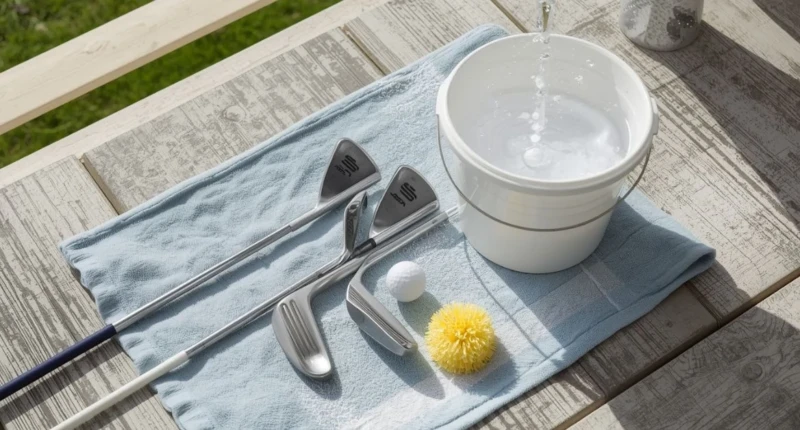Golf clubs aren’t just tools; they’re your companions on the course. Whether you’re a casual weekend golfer or someone chasing a low handicap, your clubs take a beating every round, digging into turf, hitting balls, and collecting dirt, sand, and even moisture. Over time, this grime doesn’t just affect how your clubs look; it can also hurt performance.
Why Cleaning Your Golf Clubs Matters?
Golfers sometimes underestimate the importance of clean clubs. But here’s why it makes a big difference:
- Better Performance: Dirt in the grooves affects ball spin and control. Clean grooves help you get the backspin and accuracy you want.
- Longer Lifespan: Mud, sand, and moisture can cause rust and wear. Regular cleaning protects your clubs.
- Consistent Shots: Even a small layer of dirt changes how the clubface interacts with the ball. Clean clubs = consistent results.
- Professional Look: Clean clubs show you take pride in your game. Nobody wants to pull out a rusty, muddy 7-iron.
Think of it this way: you wouldn’t drive your car for months without a wash—why do the same to your golf clubs?
What You’ll Need to Clean Golf Clubs?
Before you start, gather these simple items:
- A bucket of warm water (not too hot)
- Mild dish soap or golf club cleaner
- A soft-bristle brush (an old toothbrush works fine)
- A microfiber towel or soft cloth
- Toothpicks or groove cleaners (for deep dirt in grooves)
- Polishing cloth (optional, for extra shine)
Avoid harsh chemicals or metal brushes they can damage your clubs.
Step-by-Step Guide: How to Clean Irons and Wedges
Irons and wedges are the clubs that usually get dirtiest because they dig into the turf and sand. Here’s how to clean them:
- Fill the bucket with warm water and a few drops of dish soap.
- Soak the clubheads (only the metal part) for 5–10 minutes. Avoid dipping the shafts and grips.
- Scrub the grooves using a brush. Pay attention to the edges where dirt hides.
- Rinse under clean water to remove soap and dirt.
- Dry thoroughly with a microfiber towel to prevent rust.
- Optional polish: Use a golf-specific polish for extra shine.
Pro Tip: Use a wooden toothpick to clean stubborn dirt from grooves without scratching the clubface.
Step-by-Step Guide: How to Clean Woods and Drivers
Woods and drivers don’t usually get as dirty as irons, but keeping them clean still matters.
- Dampen a cloth with soapy water.
- Wipe the clubhead gently (don’t soak it).
- Use a brush lightly on the sole if mud is stuck.
- Rinse with a damp cloth; never submerge woods or drivers in water.
- Dry immediately with a towel.
Pro Tip: Use a headcover after every round to protect woods and drivers from scratches.
Step-by-Step Guide: How to Clean Putters
Your putter is your most-used club, and though it doesn’t dig into turf, it still collects dirt.
- Wipe the face and sole with a damp cloth.
- Use a brush on grooves or insert areas if needed.
- Dry thoroughly with a microfiber towel.
- Polish if desired for a professional look.
Cleaning Golf Club Grips
Grips often get overlooked, but they collect sweat, dirt, and oils from your hands. Slippery grips can ruin your swing.
- Mix warm water and mild soap.
- Dip a cloth and scrub the grip surface.
- Rinse with clean water (avoid soaking).
- Dry with a towel and let the grips air-dry completely.
Pro Tip: Clean grips once a month. Replace them every 12–18 months, depending on use.
Cleaning Golf Club Shafts
The shaft is just as important, especially since rust or dirt can shorten its lifespan.
- Wipe the shaft with a damp cloth.
- Use a dry towel to remove moisture.
- Check for rust spots and clean gently with a rust eraser if needed.
- Avoid using abrasive cleaners they can weaken the shaft finish.
Common Mistakes to Avoid When Cleaning Golf Clubs
Many golfers unknowingly damage their clubs while cleaning. Here’s what NOT to do:
- Don’t use boiling water it can weaken the glue holding the clubhead.
- Don’t use wire brushes; they scratch the clubface.
- Don’t soak woods or drivers’ water can damage the head.
- Don’t forget to dry the moisture leads to rust.
- Don’t use harsh chemicals, as they strip away protective coatings.
How Often Should You Clean Golf Clubs?
- After every round: Wipe down clubs and remove dirt from grooves.
- Every 3–4 rounds: Do a deeper clean with soap and water.
- Once a season: Full clean and polish for your entire set.
The more frequently you clean, the easier it is to maintain your clubs.
Tips to Make Your Clubs Last Longer
Want to extend the life of your golf clubs? Follow these tips:
- Use headcovers for woods, drivers, and putters.
- Dry clubs after rain to prevent rust.
- Store in a cool, dry place, avoiding garages or damp basements.
- Wipe clubs between shots during muddy rounds.
- Check grips regularly and replace when worn.
FAQs
1. Can I use vinegar to clean my golf clubs?
Yes, but only diluted. Vinegar helps remove rust, but should not be used often.
2. Can I put my golf clubs in the dishwasher?
No! The heat and water pressure can ruin the glue and finish.
3. What’s the fastest way to clean clubs on the course?
Carry a small brush and towel to wipe grooves after each shot.
4. How do I prevent my irons from rusting?
Always dry them thoroughly and store them in a dry place.
5. Should I polish my golf clubs?
Polishing isn’t necessary for performance but helps maintain appearance.
Final Thoughts
Keeping your golf clubs clean isn’t just about appearance—it’s about performance and longevity. A well-maintained set of clubs:
- Delivers better ball control.
- Lasts longer without rust or wear.
- Reflects professionalism and pride in your game.
By following the simple steps above, you can ensure your clubs look great, perform consistently, and stay with you for many seasons to come. Remember, clean clubs equal a cleaner game and potentially a lower score.
Also, Read this: How Many Clubs Can You Have in Your Golf Bag?




